Lyons W.C. (ed.). Standard handbook of petroleum and natural gas engineering.2001- Volume 1
Подождите немного. Документ загружается.

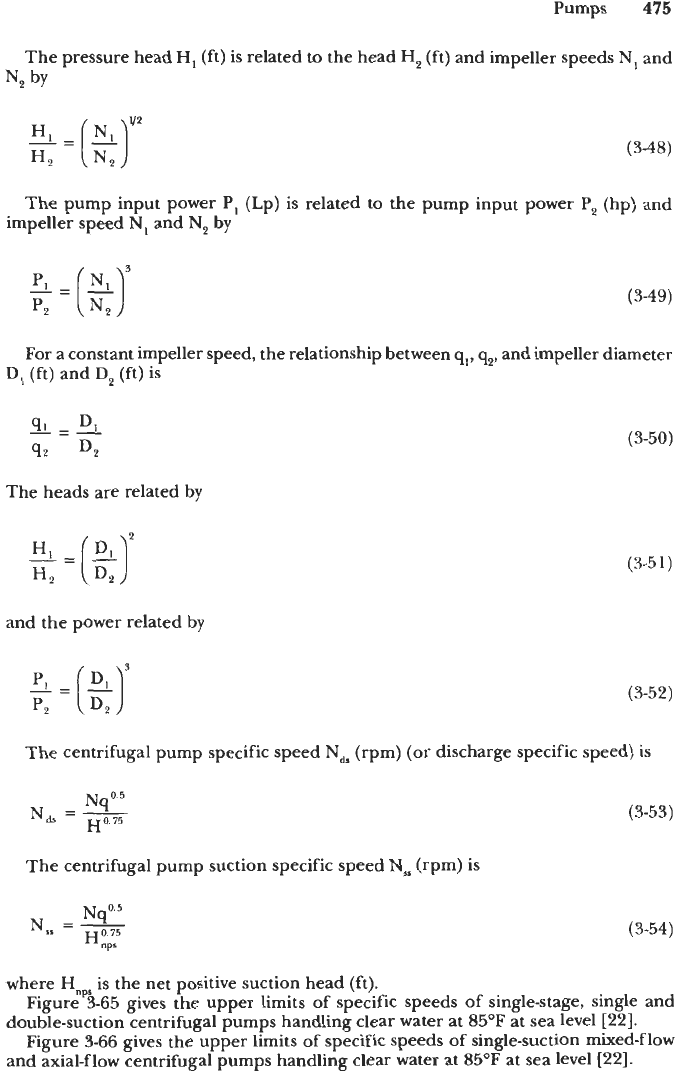
Pumps
475
The pressure head
H,
(ft) is related to the head
H,
(ft) and impeller speeds
N,
and
N,
by
The pump input power PI (Lp) is related to the pump input power
P,
(hp) and
impeller speed
N,
and
N,
by
(3-49)
For a constant impeller speed, the relationship between
q,,
q,,
and impeller diameter
D,
(ft) and
D,
(ft)
is
The heads are related
by
H,
=
(
EL)2
H,
and the power related
by
(3-50)
(3-51)
(3-52)
The centrifugal pump specific speed
NdS
(rpm) (or discharge specific speed) is
Nq0.5
N,=-
H
0.75
The centrifugal pump suction specific speed
N,
(rpm) is
(3-53)
(3-54)
where
Hnpa
is the net positive suction head (ft).
double-suction centrifugal pumps handling clear water
at
85OF
at sea level [22].
and axial-flow centrifugal pumps handling clear water at 85'F at sea level
[22].
Figure 3-65 gives the upper limits of specific speeds of single-stage, single and
Figure
3-66
gives the upper limits of specific speeds of single-suction mixed-flow
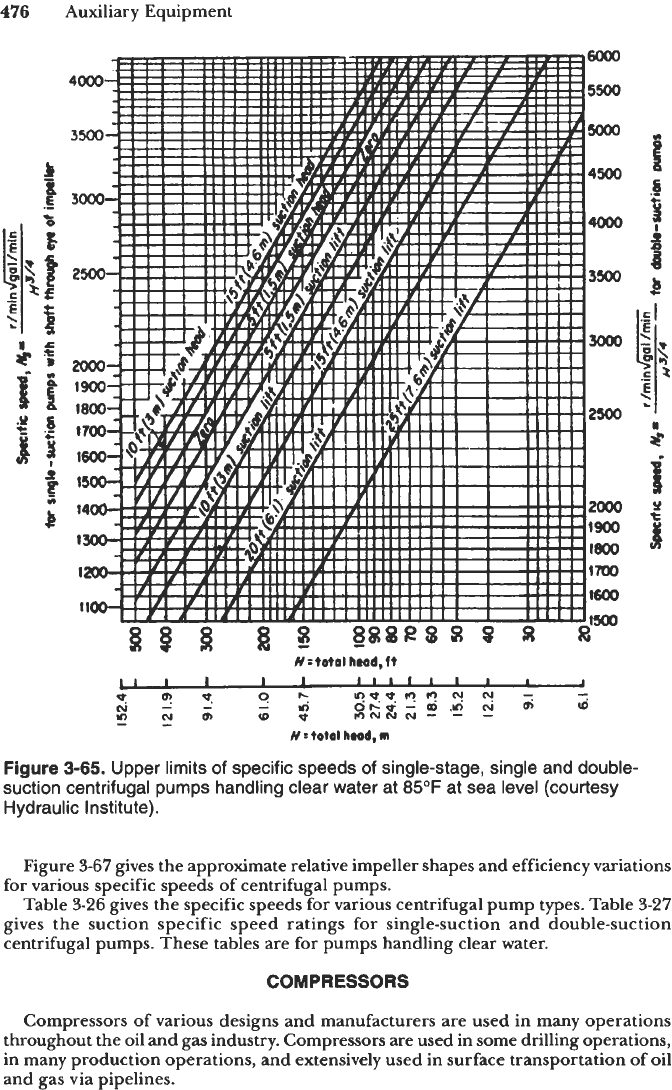
476
Auxiliary Equipment
d
Y
1
&
L
5
f
Y
jc
Figure
3-65.
Upper limits
of
specific speeds
of
single-stage, single and double-
suction centrifugal pumps handling clear water at
85°F
at sea level (courtesy
Hydraulic Institute).
Figure
3-67
gives the approximate relative impeller shapes and efficiency variations
for various specific speeds
of
centrifugal pumps.
Table
3-26
gives the specific speeds for various centrifugal pump types. Table
3-27
gives the suction specific speed ratings for single-suction and double-suction
centrifugal pumps. These tables are for pumps handling clear water.
COMPRESSORS
Compressors
of
various designs and manufacturers
are
used in many operations
throughout
the
oil
and
gas
industry. Compressors
are
used
in some drilling operations,
in many production operations,
and
extensively used in surface transportation of oil
and gas via pipelines.
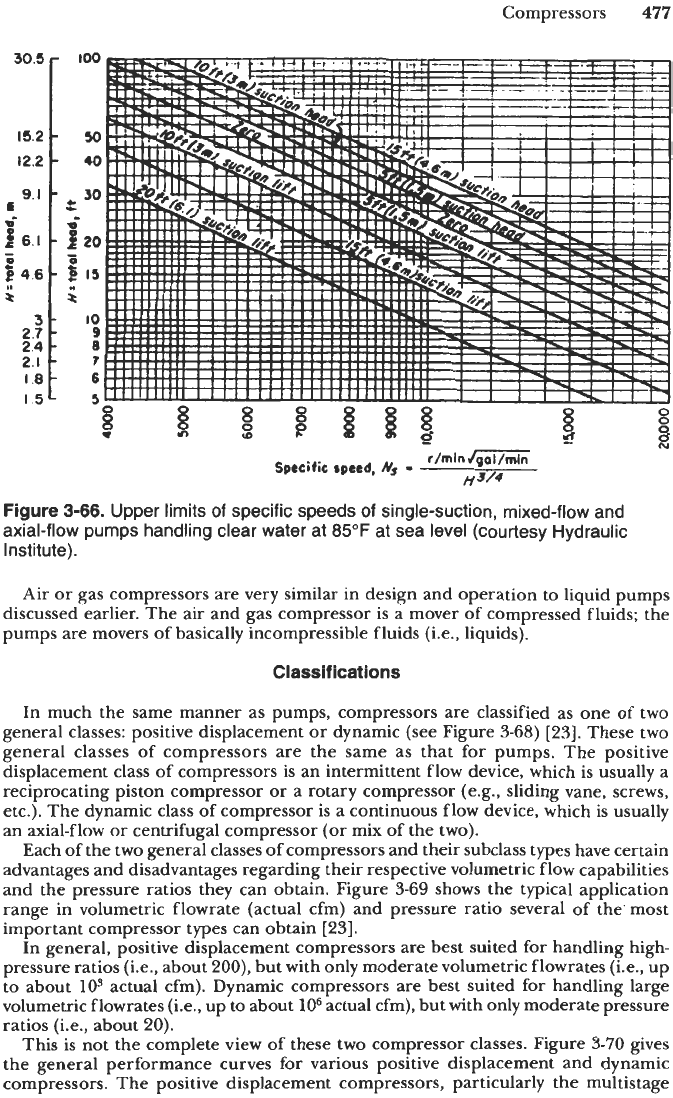
Compressors
477
N
Figure
3-66.
Upper limits
of
specific speeds
of
single-suction, mixed-flow and
axial-flow pumps handling clear water at
85°F
at sea level (courtesy Hydraulic
Institute).
Air
or
gas compressors are very similar in design and operation to liquid pumps
discussed earlier. The air and gas compressor is a mover of compressed fluids; the
pumps
are
movers of basically incompressible fluids (i.e., liquids).
Classifications
In much the same manner as pumps, compressors are classified as one of two
general classes: positive displacement
or
dynamic (see Figure
3-68)
[23].
These two
general classes of compressors are the same as that for pumps. The positive
displacement class of compressors is an intermittent flow device, which is usually a
reciprocating piston compressor or a rotary compressor (e.g., sliding vane, screws,
etc.). The dynamic class of compressor is a continuous flow device, which is usually
an axial-flow or centrifugal compressor
(or
mix of the two).
Each of the two general classes of compressors and their subclass types have certain
advantages and disadvantages regarding their respective volumetric flow capabilities
and the pressure ratios they can obtain. Figure
3-69
shows the typical application
range in volumetric flowrate (actual cfm) and pressure ratio several of the. most
important compressor types can obtain
[23].
In general, positive displacement compressors
are
best suited for handling high-
pressure ratios (i.e., about
200),
but with only moderate volumetric flowrates (i.e., up
to about
lo3
actual cfm). Dynamic compressors are best suited for handling large
volumetric flowrates (i.e., up to about
lo6
actual cfm), but with only moderate pressure
ratios (i.e., about
20).
This is not the complete view of these two compressor classes. Figure
3-70
gives
the general performance curves for various positive displacement and dynamic
compressors. The positive displacement compressors, particularly the multistage
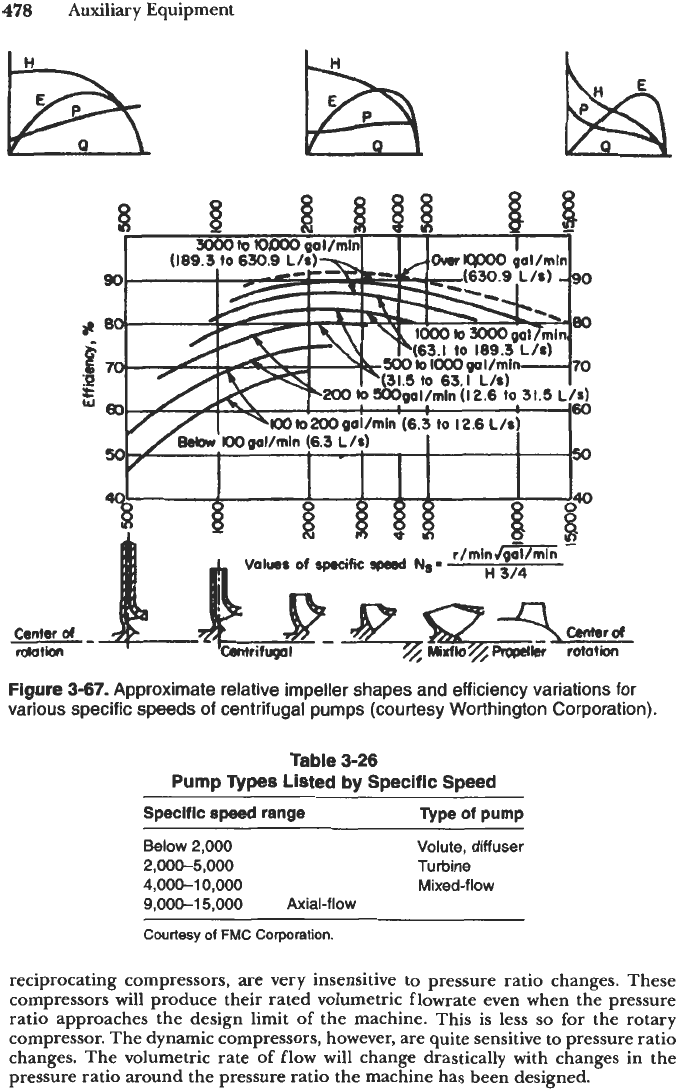
478
Auxiliary Equipment
E
Canter
of
Idation
Figure
3-67.
Approximate relative impeller shapes and efficiency variations for
various specific
speeds
of
centrifugal pumps (courtesy Worthington Corporation).
Table
3-26
Pump
Types
Listed
by
Specific
Speed
Specific
speed
range
TLpe
of
Pump
Below
2,000
Volute,
diffuser
2,000-5,000
Turbine
4,000-10,000
Mixed-flow
9,000-1
5,000
Axial-flow
Courtesy
of
FMC
Corporation.
reciprocating compressors,
are
very insensitive
to
pressure ratio changes. These
compressors will produce their rated volumetric flowrate even when the pressure
ratio approaches the design limit
of
the machine. This is less
so
for the rotary
compressor. The dynamic compressors, however, are quite sensitive to pressure ratio
changes. The volumetric rate
of
flow will change drastically with changes in the
pressure ratio around the pressure ratio the machine has been designed.
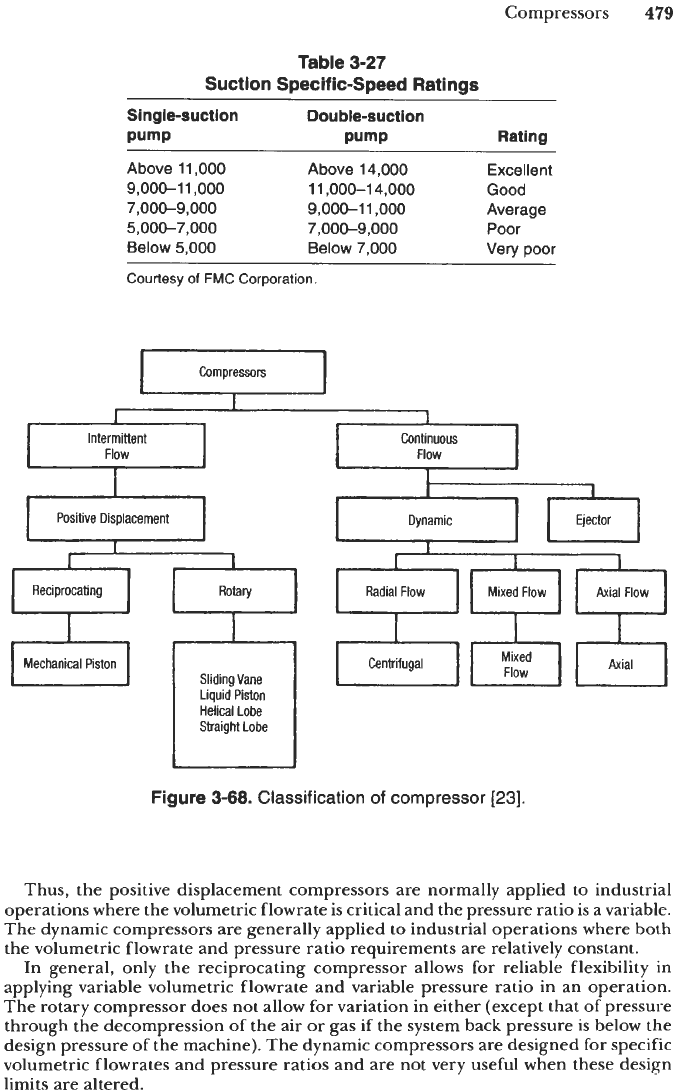
Compressors
479
Radial Flow
Table
3-27
Suction Specif ic-Speed Ratings
Single-suction Dou ble-suction
Pump Pump Rating
Mixed Flow Axial Flow
Above
11,000
Above
14,000
Excellent
9,000-11,000
11,000-1 4,000
Good
7,000-9,000
9,000-11,000
Average
5,000-7,000 7,000-9,000
Poor
Below
5,000
Below
7,000
Very
poor
Courtesy
of
FMC Corporation.
Compressors
Q
I
Intermittent
I
Flow
1
Continuous
[""I
Mechanical Piston
U
Sliding Vane
Liquid Piston
Helical Lobe
Sb-aight Lobe
Figure
3-68.
Classification of compressor
[23].
Thus, the positive displacement compressors are normally applied to industrial
operations where the volumetric flowrate is critical and the pressure ratio is a variable.
The dynamic compressors are generally applied
to
industrial operations where
both
the volumetric flowrate and pressure ratio requirements are relatively constant.
In general, only the reciprocating compressor allows for reliable flexibility in
applying variable volumetric flowrate and variable pressure ratio in an operation.
The rotary compressor does not allow for variation in either (except that
of
pressure
through the decompression of the air or gas if the system back pressure is below the
design pressure of the machine). The dynamic compressors are designed for specific
volumetric flowrates and pressure ratios and are not very useful when these design
limits are altered.
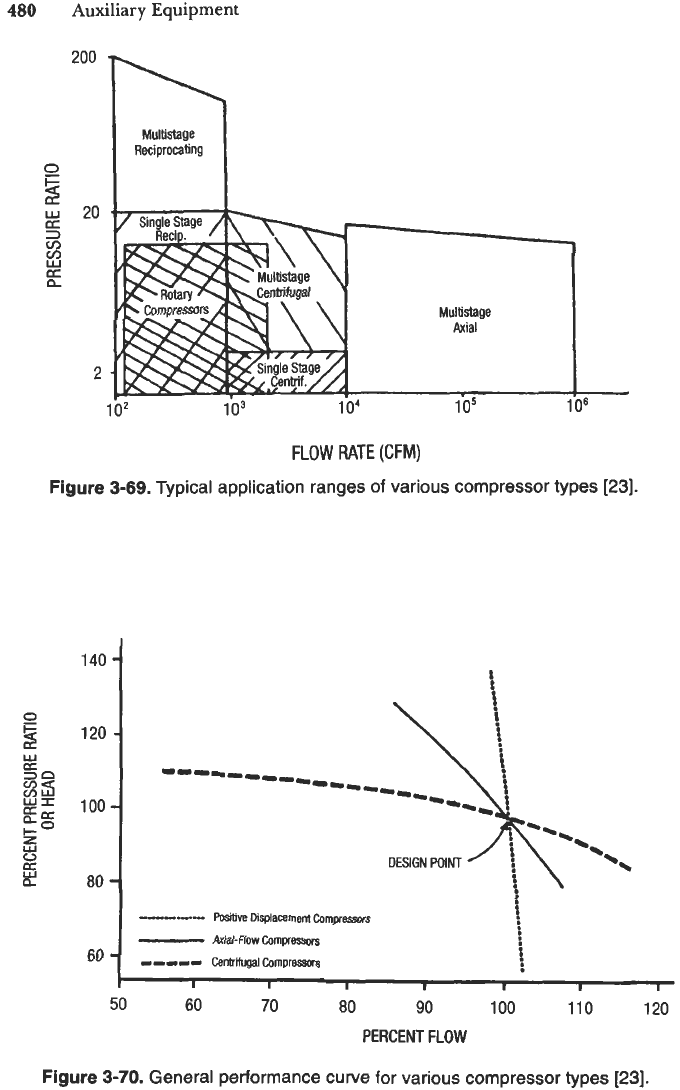
480
Auxiliary Equipment
FLOW
RATE
(CFM)
Figure
3-69.
Typical application ranges of various compressor types
[23].
Figure
3-70.
General performance curve for various compressor types
[23].
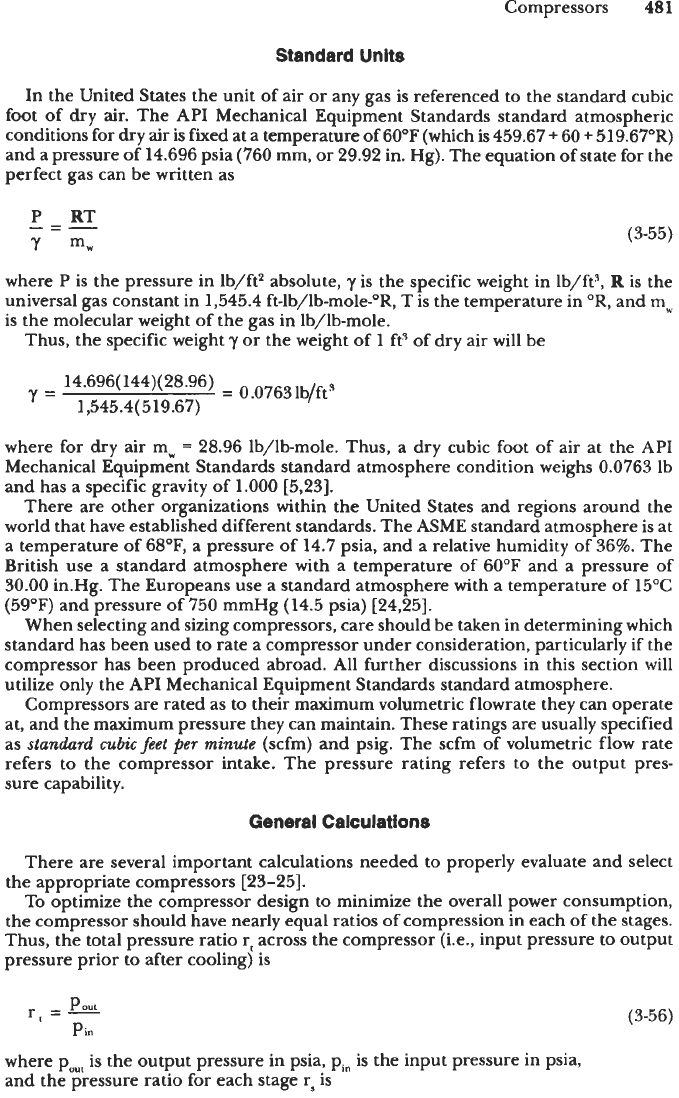
Compressors
481
Standard Units
In the United States the unit of air or any gas is referenced
to
the standard cubic
foot of
dry
air.
The API Mechanical Equipment Standards standard atmospheric
conditions for dry air
is
fixed at
a
temperature of
60°F
(which is
459.67
+
60
+
519.67OR)
and
a pressure of
14.696
psia
(760
mm,
or
29.92
in. Hg). The equation of state
for
the
perfect
gas
can be written as
P RT
Y
mw
-=-
(3-55)
where P is the pressure in Ib/ftg absolute,
y
is the specific weight in lb/ftq,
R
is the
universal gas constant in
1,545.4
ft-lb/lb-mole-OR,
T
is the temperature in
OR,
and
mw
is the molecular weight of the gas in lb/lb-mole.
Thus, the specific weight
y
or the weight of
1
fts
of
dry air will be
where for
dry
air m,
=
28.96
lb/lb-mole. Thus, a
dry
cubic foot of air at the API
Mechanical Equipment Standards standard atmosphere condition weighs
0.0763
Ib
and
has
a
specific gravity of
1.000 [5,23].
There are other organizations within the United States
and
regions around the
world that have established different standards. The ASME standard atmosphere is at
a temperature of
68"F,
a pressure of
14.7
psia, and a relative humidity of
36%.
The
British use a standard atmosphere with a temperature of
60°F
and a pressure of
30.00
in.Hg. The Europeans use a standard atmosphere with a temperature of
15%
(59°F)
and pressure of
750
mmHg
(14.5
psia)
[24,25].
When selecting and sizing compressors, care should be taken in determining which
standard has been used to rate a compressor under consideration, particularly
if
the
compressor has been produced abroad. All further discussions in this section will
utilize only the API Mechanical Equipment Standards standard atmosphere.
Compressors are rated as to their maximum volumetric flowrate they can operate
at, and the maximum pressure they can maintain. These ratings are usually specified
as
standard
cubic
feet
per
minute
(scfm) and psig. The scfm
of
volumetric flow rate
refers to the compressor intake. The pressure rating refers to the output pres-
sure capability.
General Calculations
There
are
several important calculations needed
to
properly evaluate and select
the appropriate compressors
[23-251.
To
optimize the compressor design to minimize the overall power consumption,
the compressor should have nearly equal ratios
of
compression in each
of
the stages.
Thus, the total pressure ratio
rr
across the compressor (i.e., input pressure
to
output
pressure prior to after cooling) is
r,
=
p,,t
Pin
(3-56)
where p,, is the output pressure in psia,
pi,
is the input pressure in psia,
and the pressure ratio for each stage
rs
is
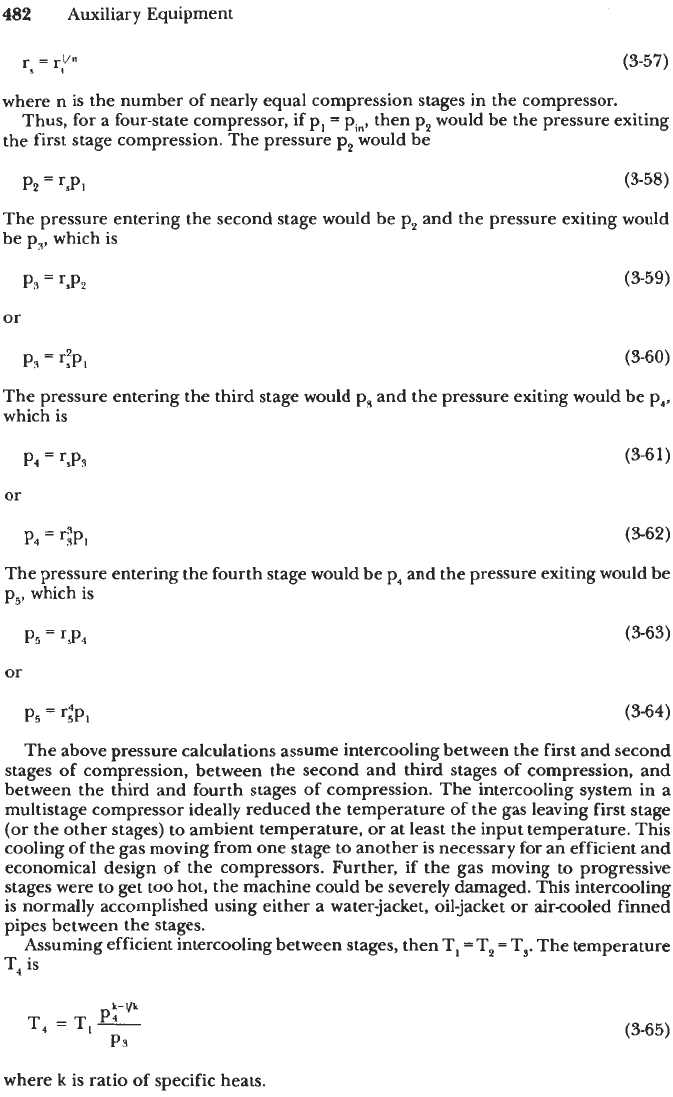
482
Auxiliary Equipment
SI
=rVn
(3-57)
where n is the number of nearly equal compression stages in the compressor.
the first stage compression. The pressure pp would be
Thus, for a four-state compressor, if p,
=
pin, then p, would be the pressure exiting
PP
=
rsPl
(3-58)
The pressure entering the second stage would be p, and the pressure exiting would
be pa, which is
P3
=
rsp2
or
P,
=
CPI
(3-59)
The pressure entering the third stage would p3 and the pressure exiting would be
p4,
which is
P4
=
r,P3
or
P4
=
rip,
(3-62)
The pressure entering the fourth stage would be p4 and the pressure exiting would be
p5, which is
P5
=
rrP4
(3-63)
or
P5
=
r$*
(3-64)
The
above pressure calculations assume intercooling between
the
first and second
stages of compression, between the second and third stages of compression, and
between the third and fourth stages of compression. The intercooling system in a
multistage compressor ideally reduced the temperature of the gas leaving first stage
(or the other stages) to ambient temperature, or
at
least the input temperature. This
cooling of the gas moving from one stage to another is necessary for an efficient and
economical design of the compressors. Further, if the gas moving to progressive
stages were to get too hot, the machine could be severely damaged. This intercooling
is
normally accomplished using either a water-jacket, oil-jacket
or
aircooled finned
pipes between the stages.
Assuming efficient intercooling between stages, then T,
=
T,
=
T,. The temperature
T,
is
p:-'k
T,
=
T,
-
P3
(3-65)
where k is ratio of specific heats.
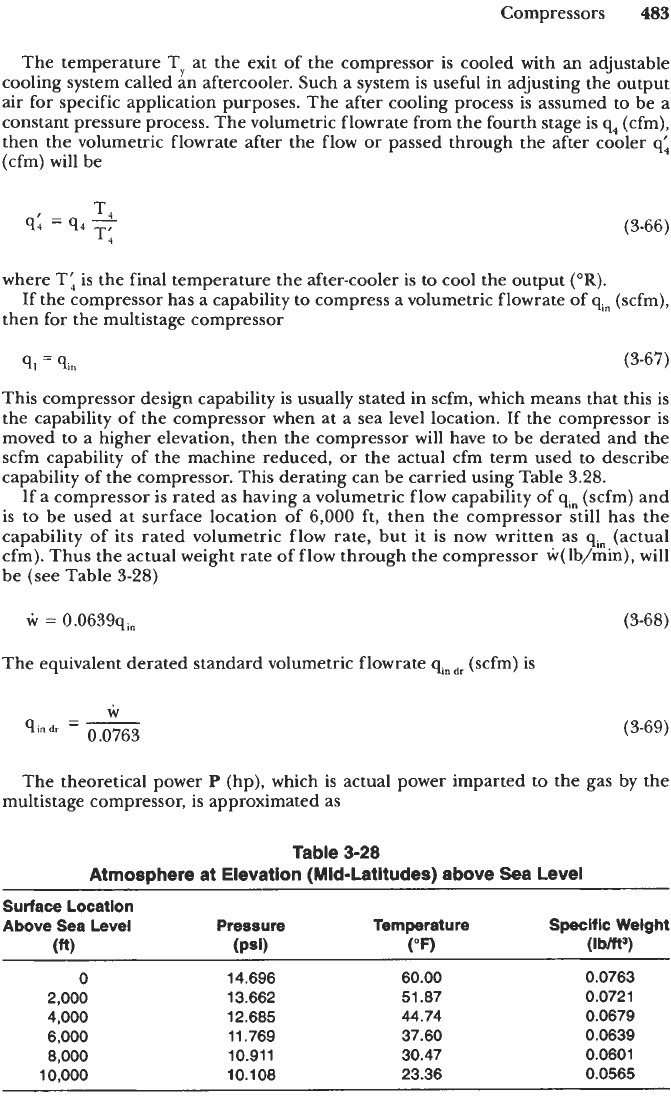
Compressors
483
The temperature
TY
at the exit of the compressor is cooled with an adjustable
cooling system called an aftercooler. Such a system is useful in adjusting the output
air for specific application purposes. The after cooling process is assumed to be a
constant pressure process. The volumetric flowrate from the fourth stage is q, (cfm),
then the volumetric flowrate after the flow or passed through the after cooler q’,
(cfm)
will
be
(3-66)
where Ti
is
the final temperature the after-cooler is to cool the output
(OR).
then for the multistage compressor
If
the compressor has a capability to compress a volumetric flowrate of
q,
(scfm),
9,
=
qi”
(3-67)
This compressor design capability is usually stated in scfm, which means that this is
the capability of the compressor when at a sea level location. If the compressor is
moved to a higher elevation, then the compressor will have to be derated and the
scfm capability of the machine reduced, or the actual cfm term used to describe
capability of the compressor. This derating can be carried using Table 3.28.
If a compressor is rated as having a volumetric flow capability of
qi,
(scfm) and
is to be used at surface location of 6,000 ft, then the compressor still has the
capability of its rated volumetric flow rate, but it is now written as qi, (actual
cfm). Thus the actual weight rate of flow through the compressor
w(
Ib/min), will
be (see Table 3-28)
w
=
0.06399, (3-68)
The equivalent derated standard volumetric flowrate qindr (scfm)
is
w
0.0763
qindr
=-
(3-69)
The theoretical power
P
(hp), which is actual power imparted to the gas by the
multistage compressor, is approximated as
Table
3-28
Atmosphere at Elevation (Mid-Latitudes) above Sea Level
Surface Location
Above Sea Level Pressure Temperature Speclflc Welght
(fi)
(PSI)
(OF)
(Irn3)
0
14.696 60.00 0.0763
2,000 13.662 51.87 0.0721
4,000
12.685 44.74 0.0679
6,000 11.769 37.60 0.0639
8,000
10.911 30.47 0.0601
10,000
10.108 23.36 0.0565
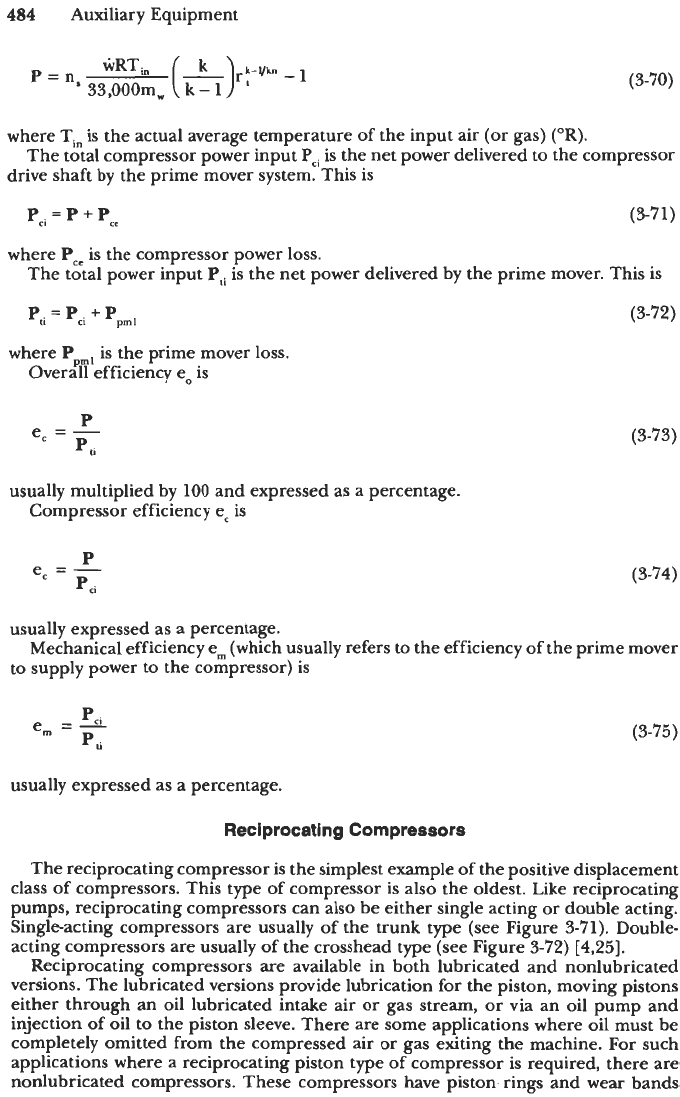
484
Auxiliary Equipment
P
=
n,
(3-70)
where
Tin
is the actual average temperature of the input air
(or
gas)
(OR).
drive shaft by the prime mover system. This is
The total compressor power input
Pci
is the net power delivered to the compressor
Pci
=
P
+
Pce
(3-71)
where
PCe
is the compressor power loss.
The total power input
Pti
is the net power delivered by the prime mover. This is
where
P,,,
is the prime mover loss.
Overall efficiency
e,
is
P
e
=-
pti
usually multiplied by
100
and expressed as a percentage.
Compressor efficiency ec is
P
e,
=
-
Pci
(3-72)
(3-73)
(3-74)
usually expressed as a percentage.
to supply power to the compressor) is
Mechanical efficiency em (which usually refers to the efficiency of the prime mover
Pci
e,,,
=
-
pti
(3-75)
usually expressed as
a
percentage.
Reciprocating Compressors
The reciprocating compressor is the simplest example of the positive displacement
class
of
compressors. This type of compressor is also the oldest. Like reciprocating
pumps, reciprocating compressors can also be either single acting
or
double acting.
Single-acting compressors are usually of the trunk type (see Figure
3-71).
Double-
acting compressors are usually
of
the crosshead type (see Figure
3-72) [4,25].
Reciprocating compressors are available in both lubricated and nonlubricated
versions. The lubricated versions provide lubrication for the piston, moving pistons
either through
an
oil lubricated intake air
or
gas stream,
or
via an oil pump and
injection of oil
to
the piston sleeve. There are some applications where oil must be
completely omitted from the compressed
air
or
gas exiting the machine. For such
applications where a reciprocating piston type of compressor is required, there are
nonlubricated compressors. These compressors have piston- rings
and
wear bands
